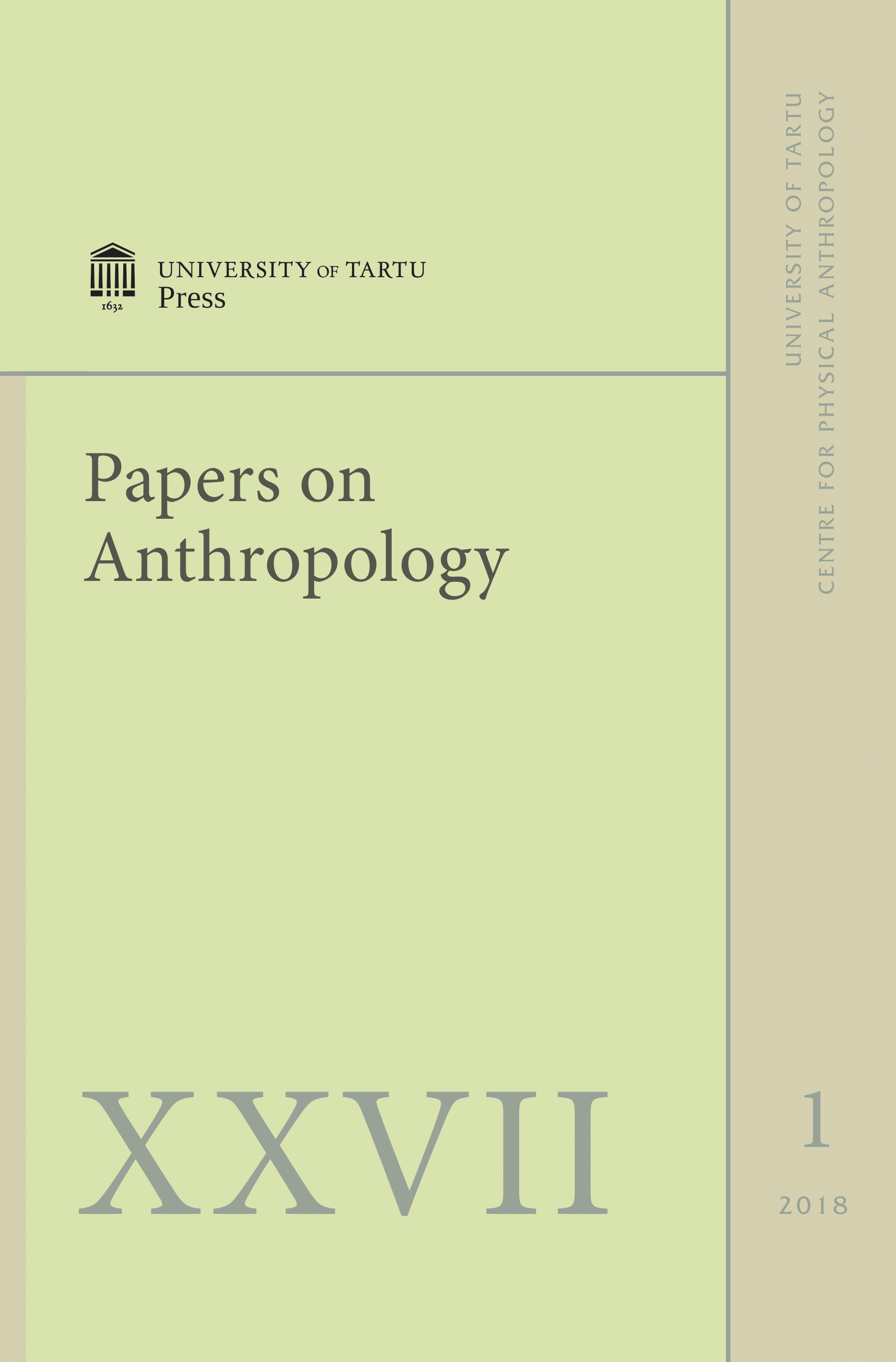T-2 mycotoxin induced apoptosis in broiler’s liver tissue
DOI:
https://doi.org/10.12697/poa.2018.27.1.01Keywords:
T-2 mycotoxin, apoptosis, broilers, liverAbstract
Apoptosis is a process of programmed cell death that occurs in multicellular organisms. As T-2 toxin is known to induce apoptosis in mammalian cells, the aim of the present experiment was to study the toxic effect of T-2 on chicken liver tissue using apoptosis-related antibodies p21 and p53 which are involved in the p53/p21-mediated apoptotic signalling pathway.
The experiment was conducted on fourteen 40-day-old broilers (Gallus gallus domesticus) who were divided into control and T-2 toxin groups. For the T-2 toxin group, T-2 toxin (Sigma, Germany) was dissolved in water and given per os for three consecutive days. The material of the liver was taken 24 hours after the last application. The specimens were fixed with 10% formalin and embedded into paraffin; slices 5 μm in thickness were cut followed by immunohistochemical staining with polyclonal primary antibodies p21 and p53 (Abcam, UK) according to the manufacturer’s guidelines (IHC kit, Abcam, UK).
Strong expression of p21 and p53 found in hepatocytes, endotheliocytes and around blood vessels together with large tissue destructions in T-2 toxin group birds’ liver indicates apoptosis and histopathological changes in liver tissue during T-2 mycotoxicosis.
Downloads
References
Bunz F., Dutriaux A., Lengauer C., Waldman T., Zhou S., Brown J.P., Sedivy J.M., Kinzler K.W., Vogelstein B. (1998). Requirement for p53 and p21 to sustain G2 arrest after DNA damage. Science, 282 (5393), 1497–1501.
Carson F.L. (1997). Histotechnology. ASCP Press, Chicago, USA.
El-Deiry W.S., Tokino T., Velculescu V.E., Levy D.B., Parsons R., Trent J.M., Lin D., Mercer W.E., Kinzler K.W., Vogelstein B. (1993). WAF1, a potential mediator of p53 tumor suppression. Cell, 75 (4), 817–25.
Ge X.H., Wang, J.P., Liu, J., Jiang, J., Lin, H.N., Wu, J., Ouyang, M., Tang, X.Q., Zheng, M., Liao, M., Deng, Y.Q. (2010). The catalytic activity of cytochrome P450 3A22 is critical for the metabolism of T-2 toxin in porcine reservoirs. Catal Commun, 12, 71–75.
Fisher M.C., Henk, D.A., Briggs C.J., Brownstein J.S., Madoff L.C., McCraw S.L., Gurr S.J. (2012). Emerging fungal threats to animal, plant and ecosystem health. Nature, 484, 186–194.
Fridman J.S., Lowe S.W. (2003). Control of apoptosis by p53. Oncogene, 22, 9030–9040.
Gartel A.L., Tyner A.L. (2002). The role of the cyclin-dependent kinase inhibitor p21 in apoptosis. Mol Cancer Ther, 1(8), 639–49.
Ihara T., Sugamata M., Sekijima M., Okumura H., Yoshino N., Ueno Y. (1997). Apoptotic cellular damage in mice after T-2 toxin-induced acute toxicosis. Nat Toxins, 5, 4, 141–145.
Kumagai S., Shimizu T. (1988). Effects of Fusarenon-X and T-2 toxin on intestinal absorption of monosaccharide in rats. Arch Toxicol, 61, 489–495.
Ishigami N., Shinozuka J., Katayama K., Uetsuka K., Nakayama H., Doi K. (1999). Apoptosis in the developing mouse embryos from T-2 toxin-inoculated dams. Histology and Histopathology, 14, 3.
Islam Z., Nagase M., Yoshizawa T., Yamauchi K., Sakato N. (1998). T-2 toxin induces thymic apoptosis in vivo in mice. Toxicol Appl Pharmacol., 48(2), 205–14.
Kachuei R., Rezaie S., Hossein Yadegari M., Safaie N., Allameh A.-A., Aref-Poor M.-A., Imani Fooladi A.-A., Riazipour M., Mohammad Abadi H.M. (2014). Determination of T-2 Mycotoxin in Fusarium strains by HPLC with
fluorescence detector. Journal of Applied Biotechnology Reports, 1, 1, 38–43.
Lei Y., Guanghui Z., Xi W., Yingting W., Xialu L., Fangfang Y., Goldring M.B., Xiong G., Lammi M.J. (2017). Cellular responses to T-2 toxin and/or deoxynivalenol that induce cartilage damage are not specific to chondrocytes. Scientific Reports, 7, 2231.
Li Y., Wang Z., Beier R.C., Shen J., De Smet D., De Saeger S., Zhang S. (2011). T-2 Toxin, a Trichothecene Mycotoxin: Review of Toxicity, Metabolism, and Analytical Methods. J Agric Food Chem, 59, 8, 3441–3453.
Rocha O., Ansari K., Doohan F.M. (2005). Effects of trichothecene mycotoxins on eukaryotic cells: a review. Food Addit Contam, 22, 369–378.
Osselaere A. (2013). Influence of deoxynivalenol and T-2 toxin on the intestinal barrier and liver function in broiler chickens. PhD dissertation, Ghent University.
Smith T.K. (1992). Recent Advances in the Understanding of Fusarium trichothecene mycotoxicoses. J Anim Sci, 70, 3989–3993.
Waldman T., Kenneth W., Vogelstein K., Vogelstein B. (1995). p21 is necessary for the p53-mediated G1 arrest in human cancer cells. Cancer research, 55, 22, 5187–5190.
Tompkins L.M., Wang H. (2011). Liver Drug Metabolism. In: Hu M., Li X. (Eds.). Oral Bioavailability – Basic Principles, Advanced Concepts, and Applications. John Wiley & Sons, Hoboken, 127–144.
Yuan G., Wang Y., Yuan X., Zhang T., Zhao Y., Huang L., Peng S. (2014). T-2 toxin induces developmental toxicity and apoptosis in zebrafish embryos. Journal of Environmental Sciences, 26, 4, 917–925.
Zhang Y., Han Y., Zhu C.C., Tang F., Cui X.-S., Kim N., Sun S.-C. (2016). Exposure to HT-2 toxin causes oxidative stress induced apoptosis/autophagy in porcine oocytes. Scientific Reports, 6, 33904.
Zhuang Z., Yang D., Huang Y., Wang S. (2013). Study on the Apoptosis Mechanism Induced by T-2. Toxin P LoS One, 8(12), e83105.

